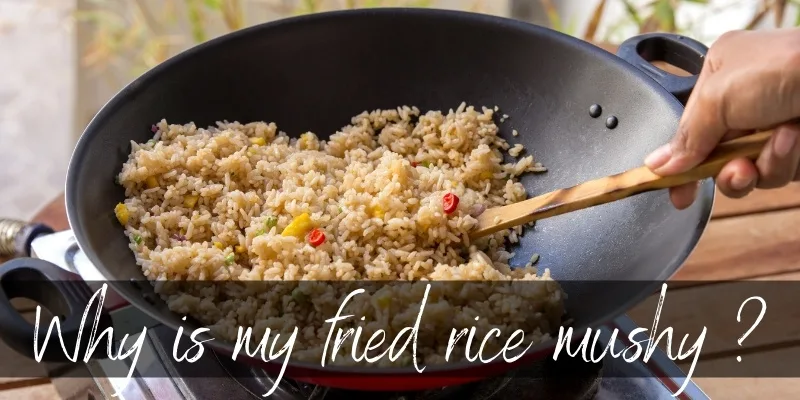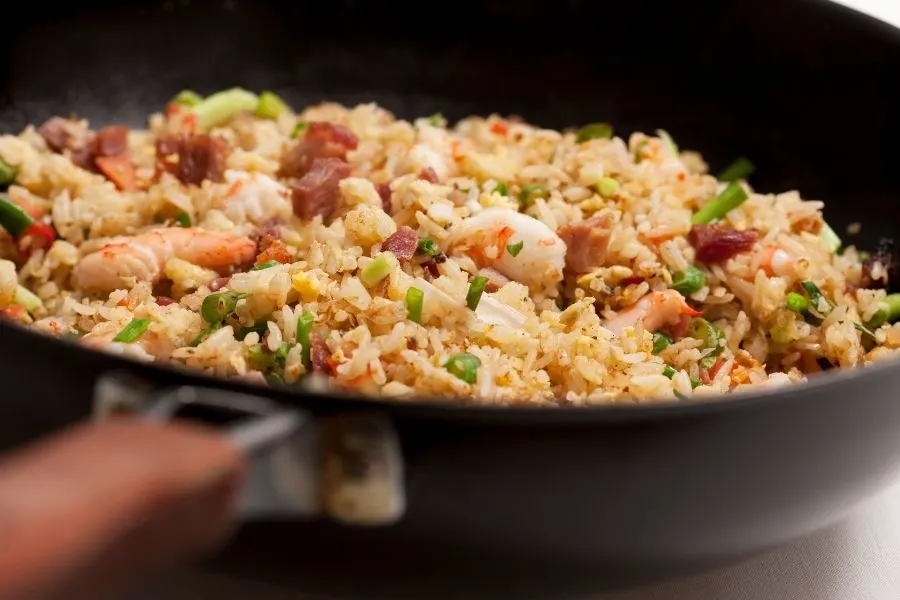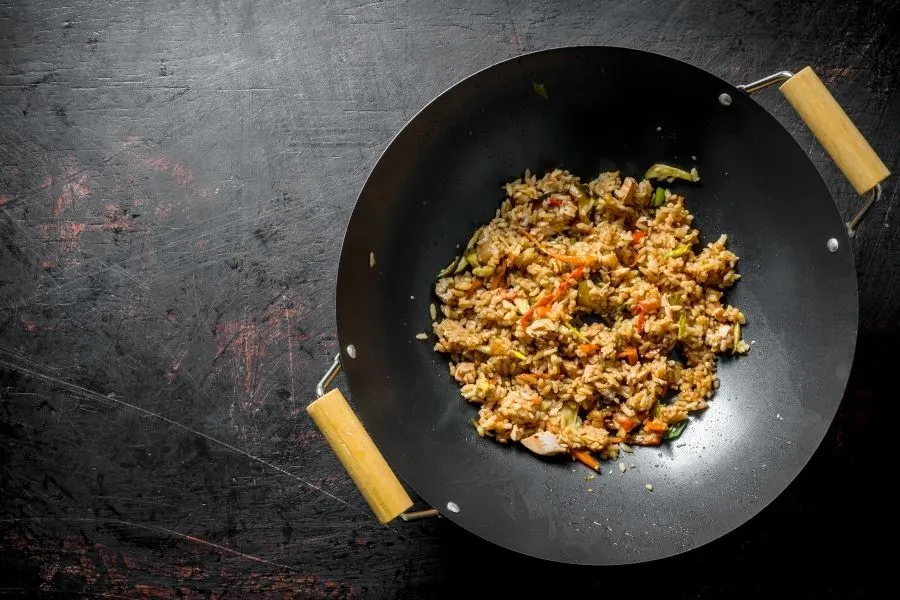When you make fried rice at home it’s very easy to get a mushy batch. It could be several reasons, which we’ll discuss below. But the result is always disappointing. Instead of perfectly cooked, separated-yet-sticky grains you get yourself a mushy, lumpy mess.
That’s alright, we’re gonna take a look at just why fried rice can end up mushy, and what to do to avoid it in the future. plus some helpful tips on getting the perfect fried rice !

Why is my fried rice mushy ?
Fried rice is mushy when there’s too much moisture in the ingredient or the rice itself. This could be due to using fresh rice, overcooked rice, ingredients that are still moist when you add the rice, or simply crowding the pan.
To get the right texture in fried rice each ingredient needs to be cooked separately or in small batches, to allow moisture to escape. Not using the right pan can make this very difficult, since woks are very large and allow large batches of fried rice.
Now let’s take a closer look at all those reasons, so you can see which case applies to you.
1. You overcooked the rice
When cooking the rice for fried rice, you need to steam it. If you’ve got a batch of leftover plain white rice that you made as pilaf or simply boiled too much, it will be very mushy. At least compared to what fried rice needs to be.
Read also: Fried Rice VS White Rice
You see fried rice grains still retain their shape and are al dente. Most European rice dishes require the rice to be fully cooked, but not just al dente. This often leads to the outer coating of the rice opening, and the rice will unfurl. You can’t make fried rice with that.
For fried rice you need 1:2, possibly 1:1.5 rice to water ratio, and to use a very well insulated pot with a good lid. Any escaping moisture will throw off your ratio and you’ll end up with rice not fully cooked through. Do not stir the rice as it is cooking ! Use a non-stick pan.
2. You used fresh rice
Another common problem when making fried rice is deciding you want it right now. So you steam a batch of fresh rice, and expect it to work just as well as day-old rice.
The trouble is that fresh rice has more moisture in it than old rice, so it will always end up mushy. If you’re thinking of letting it cool and sit for a couple of hours, it will work better. But it needs to dry out a little.
You cannot cheat this by adding less water, the inside of the rice grain will be uncooked. You need well cooked rice, and to let it dry out from the outside. It’s the only way to get the right texture.
3. There’s too much moisture in the ingredients
Fried rice is made up of more than just rice. It’s got veggies, eggs, and meat, or whatever else you decide you like. The trouble is that you may want to use ingredients that release a lot of moisture such as zucchini or mushrooms or onions or fresh meat. If you cook those and finish cooking the entire meal with the fried rice, their juices will make the rice mushy.
So make sure that there’s nothing in the pan when you add the rice. And all the ingredients need to be somewhat dry, because you’re adding some moisture later with soy sauce.
4. The pan is way too crowded
And crowding the pan. This is so easy to mess up because you may be tempted to make large batches at once (we know we are) and when you’re done adding the rice and all the ingredients you can’t easily stir the thing. Well, that’s a big problem because now is when you add the soy sauce and whatever seasoning s you like.

And if you’ve also added veggies that release a lot of water they won’t be able to dry out enough. So the result will be a mushy mess of fried rice that will simply taste too wet.
Can you save mushy rice ?
Unfortunately there is no real way to save mushy rice. You may try letting the rice itself dry out a little more in the pan, but it won’t really make a big difference. If the rice itself is too soft, there’s no saving it.
Is mushy rice overcooked or undercooked ?
Mushy rice is always a sign that the rice you’ve made is overcooked. Of course some rice types release a lot of starch and may seem mushy without actually being overcooked.
But it’s usually a sign of adding too much water, which you’ll be tempted to boil off, resulting in a batch of rice that is too soft and has no texture.
If you’re wondering if there’s any chance it’s actually undercooked, as in you need to fry the rice some more, that won’t always help. It will only help if the rice was perfectly done and you just added too much liquid or moisture with the other ingredients. Even then you may not be able to dry things out enough. Try it, but don’t get your hopes up.
Tips of getting the perfect fried rice
Alright let’s take a look at what you can do to get the perfect fried rice. This is a fairly simple recipe, but it has some key points that are crucial to understand. And often, if you mess up one you’re likely to mess up another. So here’s what to look out for.
1. Always use a wok
You may think going out to get an actual wok isn’t worth making fried rice a couple of times a month. And in truth, it’s not. But if you really want great fried rice you should go and do just that. Besides, a wok is easily used as a large pan and you may cook several other meals in it.

A wok is pretty much the only thing that will allow you enough surface heat to evenly fry everything. And it will give you enough space to stir without fear of food flying around.
If you simply use a large, flat pan, you won’t have the sides high enough to stir the rice, which you definitely need to do. Besides, the shape of a wok – rounded bottom and tall sides – allows for a lot of moisture to be released.
In our personal experience fried rice made in anything else always turns out more or less mushy.
2. Cook each ingredient separately
You may be tempted to cook in just a couple of batches, all the ingredients, and then the rice. Try not to do that, since it’s really not going to work in your favor.
The omelette needs to be cooked separately and transferred to a big bowl where you’ll keep everything. The meat needs to be cooked, separately, until it’s fully cooked. Remove that, then cook the veggies. In most fried rice recipes the veggies are usually quickly fried so they remain fresh but crisp.
The rice is always added last, and left to crisp a little. Do not stir too much now. You will stir more when adding the other ingredients and the soy sauce.
3. Always use day-old rice
Always use old rice. a day old since it will dry out just right. It needs to be cold or room temperature, don’t heat it in the microwave. If it’s clumped up it’s fine, it will break up in the wok.
4. Use sushi rice if possible
IF you use sushi rice you’re going to get the best results, since it’s somewhat sticky but very good at keeping each grain of rice separate. If you cannot find sushi rice, try going to medium or round grain, and be sure to rinse the starch off as best you can before cooking it. Do not use fresh rice !
5. Let the rice crisp up on its own in the wok
When adding the rice, let it crisp a little e in the wok. It may sound wrong, but that’s not you get the slightly crispy bits in fried rice. And yes you need to add a little oil, but it’s a small amount. It shouldn’t pool at the bottom of the wok, but it needs to coat the whole thing evenly.
The rice will have a hard time crisping up after you add all the other ingredients, so give it a chance now. Besides, it’s one of the few chances you get to bring it to a nice golden crisp color.
Read Also: How Long Does Cooked Rice Last ?
6. Be sure to cook off the soy sauce liquid
And finally, when you add soy sauce do so sparingly. You may be tempted to add more to bring it to a nice color, but the truth is the soy sauce you have at home is not the same used in restaurants or takeout places.
Plus, it’s not always just soy sauce. It’s sometimes a mix of soy sauce, oyster sauce, food coloring with turmeric, and possibly some beef stock as well for more flavor and depth of color.
If you drown it in soy sauce all you do is make it overly salty. So add a little soy sauce, yes, but have some on the table to add later when serving the rice.

